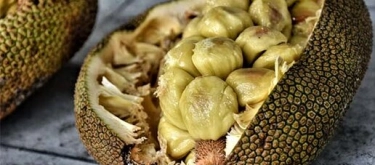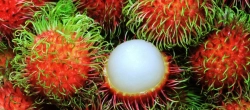Durian: Taste, Uses, Benefits and Harm
Durian, known as the “king of fruits” in Southeast Asia, is famous for its polarizing taste and potent aroma. Despite its strong smell, durian’s creamy, custard-like flesh offers a unique flavor that combines sweet, savory, and slightly bitter notes. Popular in Southeast Asian cuisine, durian is enjoyed fresh, in desserts, and even in savory dishes, making it one of the most distinctive fruits in the world.

Primary Flavor Characteristics
Durian has a complex flavor that combines sweet, creamy, and savory notes with hints of garlic, caramel, and subtle bitterness. The taste can vary significantly depending on the variety and ripeness, but it’s often described as custard-like with a sweet richness and slightly nutty undertones.
Aromatic and Taste Nuances
The aroma of durian is intense and pungent, with a sulfurous, almost onion-like scent that can be overwhelming for some. Despite the strong smell, the flavor is uniquely sweet and creamy, with layers that reveal different tastes, from caramel-like sweetness to mild bitterness.
Scientific Description of Taste and Aroma
- Aroma: Pungent, sulfurous, with notes of garlic and onions.
- Taste: Sweet, creamy, with hints of caramel, garlic, and mild bitterness.
- Texture: Soft, custard-like, and smooth.
In-Depth Flavor Analysis of Durian
Underlying Flavor Notes
Durian’s taste is multi-dimensional, with complex layers:
- Creamy Sweetness: The custard-like sweetness is rich and satisfying, with a texture similar to cream.
- Savory Undertones: Slight hints of garlic and onion add a savory quality to durian’s flavor.
- Bitterness: A mild bitterness balances the sweetness, especially near the seeds.
- Caramel and Nutty Notes: Some describe the sweetness as caramel-like, with a faint nuttiness that adds depth.
Impact of Ripeness on Flavor
- Less Ripe Durian: Firmer texture with more pronounced bitterness and a slightly milder aroma.
- Fully Ripe Durian: Soft, creamy texture with a strong aroma and a balanced mix of sweet and savory flavors.
Textural Qualities
Durian has a smooth, custard-like texture that melts in the mouth, making it ideal for both fresh eating and blending into desserts. The flesh is rich and creamy, with a soft, almost gelatinous consistency.
Culinary Uses of Durian
Primary Uses
- Fresh Eating: Durian is commonly enjoyed fresh, often as a delicacy for its unique taste and texture.
- Desserts: Durian is used in cakes, ice creams, and custards, adding a rich, creamy flavor.
- Smoothies and Shakes: Blended durian adds a tropical, creamy flavor to smoothies and milkshakes.
- Savory Dishes: In some Southeast Asian dishes, durian is used to add a creamy texture and sweet-savory flavor.
- Candies and Pastries: Durian-flavored candies, cookies, and pastries are popular in Southeast Asia, offering a milder taste.
Ideal Pairings for Durian
- Coconut Milk: Coconut’s creaminess complements durian in desserts, balancing its strong flavor.
- Sticky Rice: Sweet sticky rice enhances durian’s tropical sweetness, a popular pairing in Thailand.
- Chocolate: Dark chocolate adds a bitter contrast to durian’s creamy, sweet flavor.
- Sugar and Honey: Natural sweeteners balance the bitterness and enhance durian’s caramel notes.
- Mint and Basil: Fresh herbs add brightness, balancing durian’s richness in desserts and smoothies.
Health Benefits of Durian
Key Nutrients and Benefits
- High in Fiber: Durian provides dietary fiber, supporting digestive health and promoting satiety.
- Rich in Vitamin C and B Vitamins: These vitamins support immune health, skin health, and energy metabolism.
- Potassium and Magnesium: Essential minerals in durian contribute to heart health, muscle function, and hydration.
- Antioxidants: Durian contains antioxidants, including flavonoids and polyphenols, which help reduce inflammation.
- Natural Source of Energy: With healthy carbohydrates and natural sugars, durian provides a quick source of energy.
Potential Precautions
- Strong Smell Sensitivity: Durian’s smell can be overwhelming, and it’s banned in some public places due to its strong aroma.
- High Calorie Content: Durian is relatively high in calories and natural sugars, so moderate consumption is recommended.
- Allergic Reactions: Some people may experience mild reactions to durian, including nausea or digestive discomfort.

Tips for Choosing and Storing Durian
How to Choose Quality Durian
- Aroma and Firmness: A ripe durian will have a strong aroma and yield slightly when pressed.
- Color and Shape: Look for durians with a greenish-brown color and evenly shaped sections for consistent quality.
Storage Recommendations
- Refrigeration: Store fresh durian in an airtight container in the refrigerator for up to three days to minimize its strong smell.
- Freezing: Durian can be frozen, which preserves its flavor and reduces the aroma’s intensity when thawed.
Fun Facts About Durian
- “King of Fruits”: Durian is called the “king of fruits” in Southeast Asia, celebrated for its unique flavor and texture.
- Banned in Public Transport: Due to its strong odor, durian is prohibited in some public transportation systems and hotels.
- Variety in Flavors: There are many types of durian, with flavors ranging from mild and creamy to intense and pungent.









